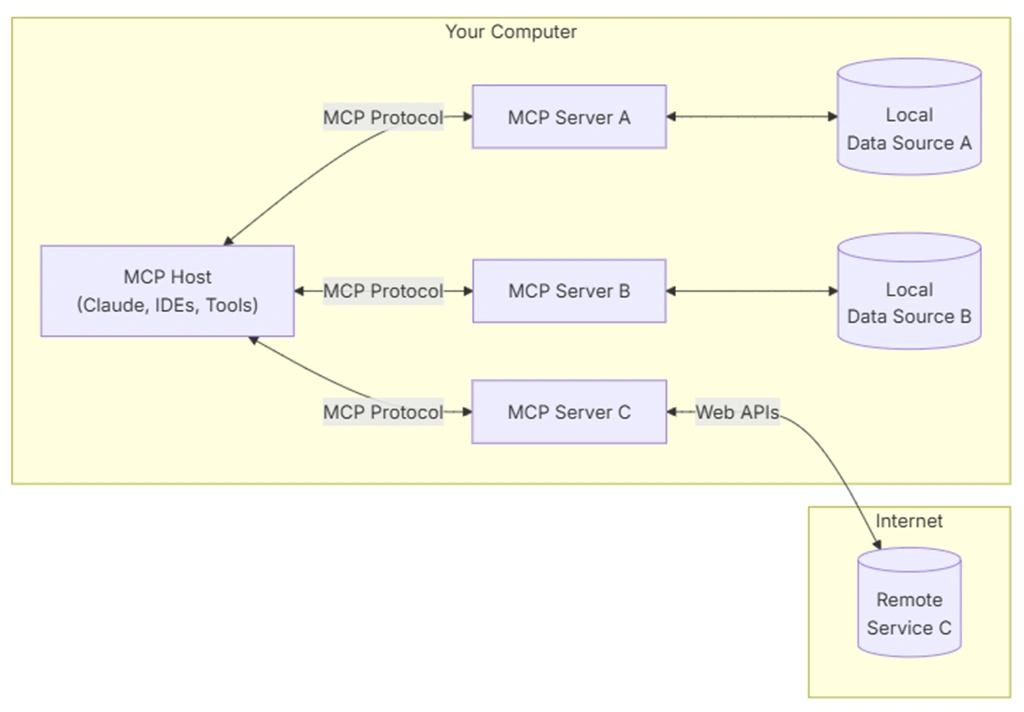20 May What is MCP and why it’s important?
What is MCP?
Much like how USB-C provides a single connector for different devices, Model Context Protocol (MCP) is an open standard that defines a common protocol for connecting AI models-especially large language models (LLMs) – with external applications, tools, and data sources. MCP serves as a universal interface, allowing AI systems to interact with various software and services using a standardized method, eliminating the need for custom integration.
Why is MCP important?
MCP addresses a key challenge in AI integration: previously, each AI tool or assistant required custom-built adapters to communicate with different applications. This approach was inefficient and limited scalability. MCP solves this by offering a single, consistent protocol that any compatible tool or service can implement, enabling seamless interoperability between AI models and a wide array of digital resources.
The importance of MCP can be summarized as follows:
- Standardization – MCP creates a unified language for AI-to-software communication, reducing the need for bespoke integrators
- Scalability – with MCP, one AI assistant can potentially interact with thousands of tools, as long as they support protocol
- Extensibility – new services or tools can be added by simply implementing MCP, without modifying the AI model itself
- Security and control – MCP uses a client-server architecture, allowing secure access to local files, databases and remote services as needed
How is MCP used?
MCP is typically used in scenarios where an AI assistant needs to perform actions or retrieve information from external systems.
Examples include:
- an AI code editor (like Cursor) creating a GitHub respiratory or managing files directly through MCP, instead of requiring manual user intervention
- AI assistants fetching data from business databases, editing designs in applications like Figma, or controlling media players-all through a standardized interface
- automating workflows where the AI can discover available services, understand their capabilities and invoke them using the MCP protocol, streamlining tasks across diverse software environments
In practice, MCP transforms AI assistants from passive conversational agents into active participants capable of executing real-world actions across digital ecosystems.
General architecture
At it’s core, MCP follows a client-server architecture where a host application can connect to multiple servers:

- MCP Hosts: programs like Claude Desktop, IDEs or AI tools that want to access data through MCP
- MCP Clients: Protocol clients that maintain 1:1 connections with servers
- MCP Servers: Lightweight programs that each expose specific capabilities through the standardized Model Context Protocol
- Local Data Sources: Your computer’s files, databases, and services that MCP servers can securely access
- Remote Services: External systems available over the internet (e.g., through APIs) that MCP servers can connect to
MCP for Mint
MCP for MintHCM is coming soon and will be available on GitHub.
It will include 12 tools (initially, the tool will of course be expanded):
- Create record – creating a record (e.g., creation of a record of candidates during recruitment)
- Create meeting – a separate tool for creating meetings
- Delete record – deleting record
- Check availability – checking a user’s availability based on their scheduled meetings and calls
- Calendar – checking the current date and events that take place that day
- Get Module Names – retrieving the names of modules the user has access to
- Get Modules Fields – retrieving information about fields in modules the user has access to
- Get Users – retrieving data of users available in the system (first name, last name, supervisor, phone numbers, etc.)
- Mint Search Tool – access to a filtered list of records from a given module (e.g., which candidates born after 1995 are available in the system)
- Mint Count Tool – counting records from a filtered list (e.g., how many candidates born after 1995 are there)
- Mint Sum Tool – summing values based on a specific field for a filtered list (e.g., count how many hours of meetings I have in a week)
These are the first MCP functions that will be implemented in MintHCM, but they will definitely continue to develop and their number will keep increasing.

